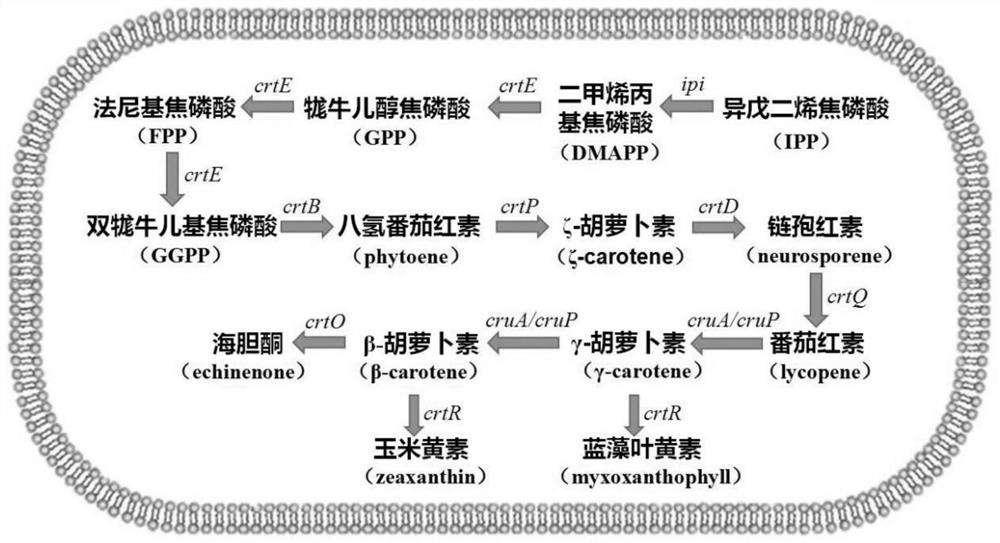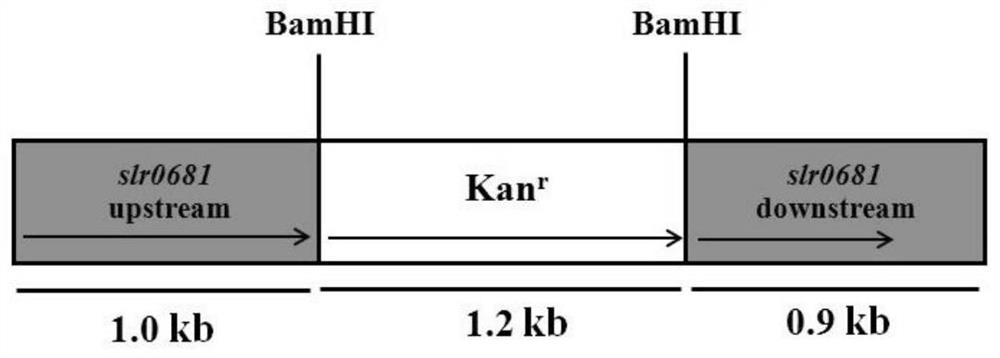Application of slr0681 gene in synthesis of synechocystis carotene
A technology of carotene and Synechocystis, applied in the field of genetic engineering
- Summary
- Abstract
- Description
- Claims
- Application Information
AI Technical Summary
Problems solved by technology
Method used
Image
Examples
Embodiment 1
[0090] Construction of slr0681 gene knockout (insertion inactivation) plasmid:
[0091](1) Taking the sequences shown in SEQ ID NO.3 and SEQ ID NO.4 in the sequence table as upstream primers respectively, and taking the sequences shown in SEQ ID NO.5 and SEQ ID NO.6 as downstream primers respectively, from Synechocystis sp. PCC 6803 The upstream and downstream fragments of the slr0681 gene were respectively amplified from the genomic DNA;
[0092] (2) The two gene fragments were connected to the T3 cloning vector and then transformed into Escherichia coli DH5α, and the positive clones were screened and sequenced to obtain the slr0681-T3 plasmid;
[0093] (3) the slr0681-T3 plasmid is single-digested with BamH I, and the vector fragment is recovered;
[0094] (4) Use BamH I to digest the pBluescript-Kan vector, and reclaim the kanamycin-resistant fragment;
[0095] (5) transforming into Escherichia coli DH5α after connecting the vector fragment and the kanamycin-resistant fra...
Embodiment 2
[0103] Obtaining of slr0681 gene knockout (insertion inactivation) mutant strain:
[0104] Take the logarithmic culture period (OD 730 =0.6) (Culture condition: BG-11 liquid medium, 30°C, light condition 40μmolphoton m -2 ·s -1 ) wild-type Synechocystis PCC6803 culture solution 4ml, at room temperature, centrifuge at 4,000rmp for 10min, discard the supernatant; add fresh BG-11 liquid medium to wash once, centrifuge, remove the culture solution, and resuspend the algae cell sediment Suspend in 1 mL of BG-11 medium, add 15 μL of the recombinant plasmid (pΔslr0681) prepared in Example 1, and incubate for 6 hours under low light conditions (light conditions: 10 μmol photon m -2 ·s -1 , the temperature is 30°C), during which the mixture was slightly inverted and mixed once. Then, spread the mixed culture of Synechocystis and plasmid on the nitrocellulose filter membrane of BG-11 solid plate, and cultivate it in the light incubator for 24 hours (cultivation condition: 30°C, ligh...
Embodiment 3
[0106] PCR detection of slr0681 gene knockout mutant strain:
[0107] Using wild-type Synechocystis sp. PCC6803 and Δslr0681 as materials, the total DNA was extracted for PCR detection and analysis. The specific method is as follows: DNA was extracted from wild-type Synechocystis PCC6803 and Δslr0681 using DNA extraction phenol reagent (purchased from Solarbio Company) and glass bead shaking method. The specific operation steps are as follows: take 2mL OD 730 =0.6 cyanobacteria, collect algal cells by centrifugation at 12,000rpm at room temperature for 1min, add 0.4mL 1×TE Buffer and an appropriate amount of glass beads with a diameter of about 0.17mm (purchased from sigma company) until there is 0.5mL of suspension above the glass bead interface . Via a vortex shaker at the maximum speed for 1 min, then add 0.4 mL DNA extraction phenol reagent. Centrifuge at 12,000rpm for 10min, take the supernatant into a new 1.5mL centrifuge tube, add 0.4mL Tris saturated phenol / chlorofo...
PUM
 Login to View More
Login to View More Abstract
Description
Claims
Application Information
 Login to View More
Login to View More - R&D
- Intellectual Property
- Life Sciences
- Materials
- Tech Scout
- Unparalleled Data Quality
- Higher Quality Content
- 60% Fewer Hallucinations
Browse by: Latest US Patents, China's latest patents, Technical Efficacy Thesaurus, Application Domain, Technology Topic, Popular Technical Reports.
© 2025 PatSnap. All rights reserved.Legal|Privacy policy|Modern Slavery Act Transparency Statement|Sitemap|About US| Contact US: help@patsnap.com



